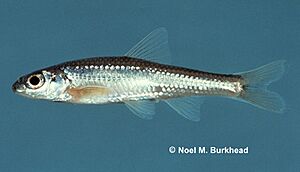Bigeye chub facts for kids
Quick facts for kids Bigeye chub |
|
|---|---|
 |
|
| Conservation status | |
| Scientific classification | |
| Synonyms | |
|
The Bigeye chub (Hybopsis amblops) is a small freshwater fish. It belongs to the carp family, known as Cyprinidae. This fish gets its name from its noticeably large eyes.
Contents
Where Bigeye Chubs Live
The Bigeye chub lives in many parts of the eastern and central United States. You can find them in areas around Lake Ontario and Lake Erie in states like New York, Pennsylvania, Ohio, and Michigan. They also live in the Ohio River basin, stretching from New York all the way to eastern Illinois. Further south, they are found in the Tennessee River drainage, Georgia, and Alabama.
These fish also make their home in the Ozarks region, which covers southern Missouri, northern Arkansas, and northeastern Oklahoma. While they are mostly found in these areas, there was one time a Bigeye chub was seen in the Cottonwood River in Kansas. However, they are not found in the Missouri River drainage. In Illinois, the Bigeye chub is currently listed as a threatened species, meaning its population needs protection.
Bigeye Chub Homes
Bigeye chubs are freshwater fish that like specific kinds of homes. They prefer to live near riffles, which are shallow, fast-moving parts of a stream or river. They also like quiet water areas that have lots of water plants.
These fish thrive in small to medium-sized rivers and streams that have clear water. The bottom of their home needs to be sandy, gravelly, or rocky. They really do not like siltation, which is when too much mud or dirt makes the water cloudy and covers the riverbed. Clear water and clean bottoms are very important for them to survive.
What Bigeye Chubs Look Like
The Bigeye chub has a unique look. It has a long, somewhat blunt snout and a mouth that points downwards. Its body is a light greenish-yellow color. A distinct black stripe runs along its side, from its mouth all the way to its tail.
Like other fish in the Hybopsis group, the Bigeye chub has a special feature: a single barbel (a whisker-like growth) near its mouth. This barbel has taste buds, which help the fish find food. As its name suggests, the Bigeye chub has large, oval-shaped eyes that point upwards. These fish are quite small, usually growing to be about 2 to 3 inches long.
What Bigeye Chubs Eat
Bigeye chubs are insect eaters! Their diet mainly consists of aquatic insects. This includes different kinds of larvae, which are the young forms of insects, and large mayflies. They use their special mouth barbel and upward-pointing eyes to help them find these tasty meals in their clear water homes.
History of the Bigeye Chub
The Bigeye chub faced some tough times in the middle of the 20th century. Their numbers dropped sharply, especially in the 1970s and 1980s. People even thought they might have completely disappeared from some areas, a term called extirpated.
However, thanks to conservation efforts and research, things have started to look up for the Bigeye chub. Since the year 2000, their populations have been steadily increasing, especially in central Illinois. Because of these recovery methods, they are now considered a threatened species in Illinois, meaning they are still at risk but are being protected.


